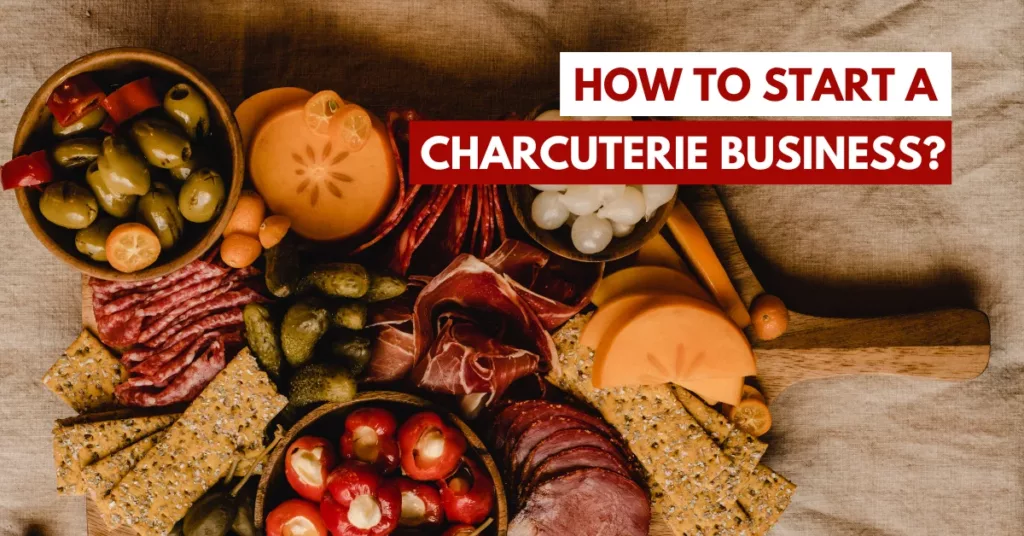Have you ever seen those fancy platters with delicious meats and cheeses that look like edible art? Well, these platters are called charcuterie boards. If you love making beautiful and tasty charcuterie boards that people love to look at and eat, you might want to turn your hobby into a cool board business.
In this guide, we’ll learn how to start a charcuterie board business and find your special place in the world of food creativity. There are many different kinds of food-related business opportunities available, such as bakeries, food trucks, and catering services. A particularly enjoyable niche within this industry is the market for charcuterie boards.
In recent years, charcuterie boards have become incredibly popular and are now in high demand as the focal point of events, parties, and special occasions. Your dream business could be a charcuterie board if you’re passionate about beautifully arranging meats, cheeses, and other delicious ingredients.
What Exactly is a Charcuterie?
There has been a delightful resurgence of an ancient practice in the culinary world in recent years, and that practice is charcuterie. Charcuterie is the art of preserving and preparing meats, usually through curing, smoking, and flavoring. The word comes from the French words “chair” (flesh) and “cuit” (cooked). Nonetheless, the modern take on this age-old custom is found in the growing popularity of charcuterie boards.
As an elegant combination of flavor and design, these exquisitely arranged boards have won the hearts and palates of foodies all over the world. Along with tempting tastes, this trend has opened up a fantastic business opportunity for entrepreneurs who want to explore the culinary and handicraft industries.
Analysis of Markets and Research
Gaining a thorough grasp of your target market and the competitive environment is essential when launching a charcuterie board business. This part of your business plan is essential to make sure you are not only providing a unique product but also successfully establishing your position in the market. You will also be able to determine business ideas during the analysis.
A. Determining Who Your Target Market Is
Finding your target market is a crucial first step in starting business. Because of their versatility, charcuterie boards are popular with a variety of customers. On the other hand, you can more successfully customize your goods and marketing tactics by identifying your target market.
Take into account variables like location, lifestyle, and demographics. Are you serving the neighborhood’s young professionals, food enthusiasts, event coordinators, or the local community? You can make boards that appeal to your target audience and develop marketing messages that directly address their interests by getting to know their preferences and needs.
B. Examining the Rivals
Finding opportunities and gaps in the market requires analyzing the competitive landscape. Start by investigating local charcuterie board companies or those that cater to your target market. The range of products and services, pricing policies, and distinctive selling propositions of other businesses may be discovered through this research.
Analyze these companies’ advantages and disadvantages, then use the results to hone your own business plan. It is possible to find a market that hasn’t been filled yet, or you can set yourself apart from the competition with unique ingredients or presentation techniques. Making informed choices regarding the positioning and marketing of your company can be aided by studying your competitors.
C. Market Trends and Demand
Long-term success depends critically on understanding demand and keeping an eye on market trends. Though their popularity has recently increased, charcuterie boards could change in the future like any trend. Keep up with dietary trends, shifting tastes, and the demand for particular ingredients.
If you want to know what interests your target audience and get insightful feedback, think about surveying them or having direct conversations. To stay current on new trends, you should also follow food industry reports, visit trade exhibitions, and participate in pertinent online communities. Over time, you can keep your business competitive and relevant by making necessary adjustments to your offerings in response to changing market demands.
Additionally, you can more efficiently plan your inventory and marketing initiatives if you are aware of the seasonality of demand. For example, charcuterie boards are frequently in great demand for special occasions like weddings and holidays. Sales can increase, and a loyal customer base can be built by being ready to meet these trends.
Skills and Expertise
The key to standing out in the competitive world of business is to develop your skills. Immerse yourself in a continuous experimentation journey if you want to truly excel in this culinary art. Explore a wide range of flavors and textures by delving into a rich palette of ingredients to make innovative and appealing combinations.
Invest in your knowledge by taking culinary courses, attending workshops, or training under an experienced coach. This complex skill requires much more than just arranging cheeses and meats; it also necessitates a deep comprehension of artistic composition, flavor profiles, and the science of pairing foods that appeal to the palate. Because this learning process is the cornerstone of your future success, patience is essential. Don’t rush it!
Legal Requirements
Legitimate businesses are built on legal requirements. When you start your board business, you must navigate a complex web of regulations and procedures to ensure that your business activities are legal.
First and foremost, you must register your business officially. Choosing a business structure, such as a corporation, LLC, or a private company, and obtaining the necessary licenses and permits are usually involved in this step. These legal requirements differ from one region to the next, so it is important to find out what your local government or legal expert requires.
Health and safety regulations are extremely important in the food industry. You might have to set up a commercial kitchen or rent a licensed kitchen space in order to comply with regulations regarding the preparation and storage of food. To guarantee the quality and security of your charcuterie products, these establishments have to adhere to strict sanitary and safety regulations.
Following these rules is not just required by law but also demonstrates your dedication to your client’s well-being. All things considered, maintaining compliance with legal requirements is essential to building credibility and trust in your business and protecting your operations from future legal problems.
Branding and Marketing
The success of your charcuterie board business depends critically on your branding and marketing strategies. A distinctive brand identity helps you stand out in an increasingly competitive marketplace. Whether it’s modern and sophisticated or traditional and charming, your company name and logo should be thoughtfully created to express who you are.
Your online presence is just as important; a well-designed website gives you a platform to share your story, exhibit your creations, and make it simple for prospective clients to find you. In this era of digital technology, social media is your best friend. Utilize social media sites like Facebook, Pinterest, and Instagram to visually captivate your audience with mouthwatering images of your charcuterie boards.
Share behind-the-scenes content with your followers, such as your sourcing adventures or creative process, to engage them. Engaging with your audience promotes consumer loyalty in addition to creating a feeling of community. It is important to invest in high-quality images that will make your offerings irresistible because food photography has a powerful influence. Not only can strong branding and marketing attract consumers, but they will also keep coming back for more.
Sourcing Ingredients
The key to making outstanding charcuterie boards is sourcing premium ingredients. Your edible artwork is constructed from a variety of ingredients, such as cured meats, handcrafted cheeses, fresh fruits, nuts, and different condiments. Building relationships with reliable suppliers is essential to ensuring the best flavors and textures.
Seek suppliers that place an emphasis on artisanal craftsmanship, quality, and freshness because these attributes will be evident in the finished product. Developing a close relationship with local vendors can revolutionize your business. Purchasing locally not only benefits the community but also gives you access to unique, in-season ingredients that can elevate your dishes.
Equipment and Supplies
Your business is built on the tools and supplies you purchase, which guarantee that you can produce consistently excellent creations. Here is a more detailed look at what you will require:
- Cutting Boards and Knives: For flawless slicing and presentation, a range of knives and premium cutting boards are necessary. Invest in a variety of knives to handle different ingredients, such as chef’s, paring, and serrated knives.
- Serving Platters and Utensils: Using a variety of serving platters—from sophisticated porcelain plates to traditional wooden boards—will enhance the visual appeal of your charcuterie boards. For a full presentation, pair them with a variety of utensils such as spreaders, tongs, and cheese knives.
- Storage: Proper refrigeration and storage are essential for preserving the freshness of perishable items. Purchase storage bins and refrigeration equipment of the highest caliber for your business to help preserve the freshness of your ingredients. Maintaining a consistent temperature is essential for food safety.
- Presentation Supplies: In addition to being delicious, your charcuterie boards are a visual feast. Slate trays, wooden boards, and other presentation supplies give your work personality and charm. These can be a powerful selling point and should complement the style of your brand.
- Packaging Materials: Invest in safe and aesthetically pleasing packaging materials to guarantee your charcuterie boards arrive at your customers in perfect condition. This could include boxes, insulation, and wrapping that is safe for food to be transported at the proper temperature.
Pricing Strategy
Setting the right price for your charcuterie boards requires striking a careful balance between keeping costs down and giving customers what they want. The quality and variety of the cured meats, cheeses, and accompaniments you use should be reflected in the price of your ingredients. Take into account the time and energy you put into getting ready, since this is where your board’s true artistry comes to life.
Don’t forget to include overhead expenses like kitchen space, equipment, and packaging materials. Finally, decide on your ideal profit margin. It should be in proportion to your expertise and creativity. Finding the ideal balance will guarantee that your prices are competitive, attracting customers to your charcuterie boards and encouraging the growth of your company.
Feedback and Adaptation
Two fundamental components of a successful charcuterie board business are feedback and adaptation. Consumer reviews act as a compass to point you in the direction of excellence. In addition to building trust, asking for client testimonials and reviews offers useful information about their preferences. Take careful note of what your customers like about you and what they would like to see improved.
Final Thoughts
In conclusion, launching a board business is an exciting journey that combines your artistic creativity with your culinary expertise. It is not just a culinary endeavor. It necessitates careful preparation, firm devotion, and a constant dedication to excellence. A strong sense of adaptation and a never-ending thirst for knowledge are necessary for success.
Keep a watch on the evolving trends and tastes in the world of charcuterie. Allow your culinary creativity to captivate your clients’ hearts in addition to their taste buds with each platter. Transform your hobby into an income-producing and memorable culinary business by following your passion.
Frequently Asked Questions (FAQs)
Q: Are charcuterie boards profitable?
A: Board business can be profitable if they are managed with innovation, quality ingredients, and successful marketing.
Q: How much should I charge for charcuterie?
A: A charcuterie board can cost anywhere from $15 to $30 per person for a standard board with quality ingredients and more for premium or custom offerings.
Q: Is charcuterie expensive?
A: Charcuterie can be pricey due to the high-quality cured meats, artisanal cheeses, and premium accompaniments that are frequently used in the preparation of these boards.



